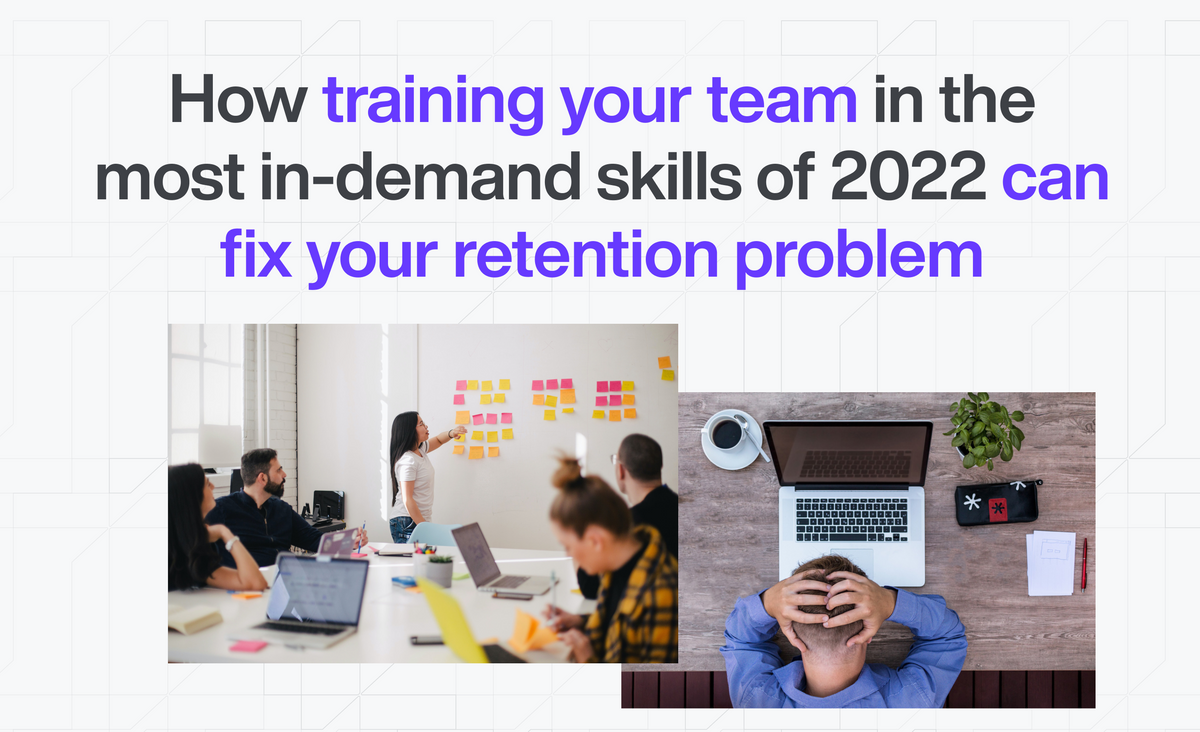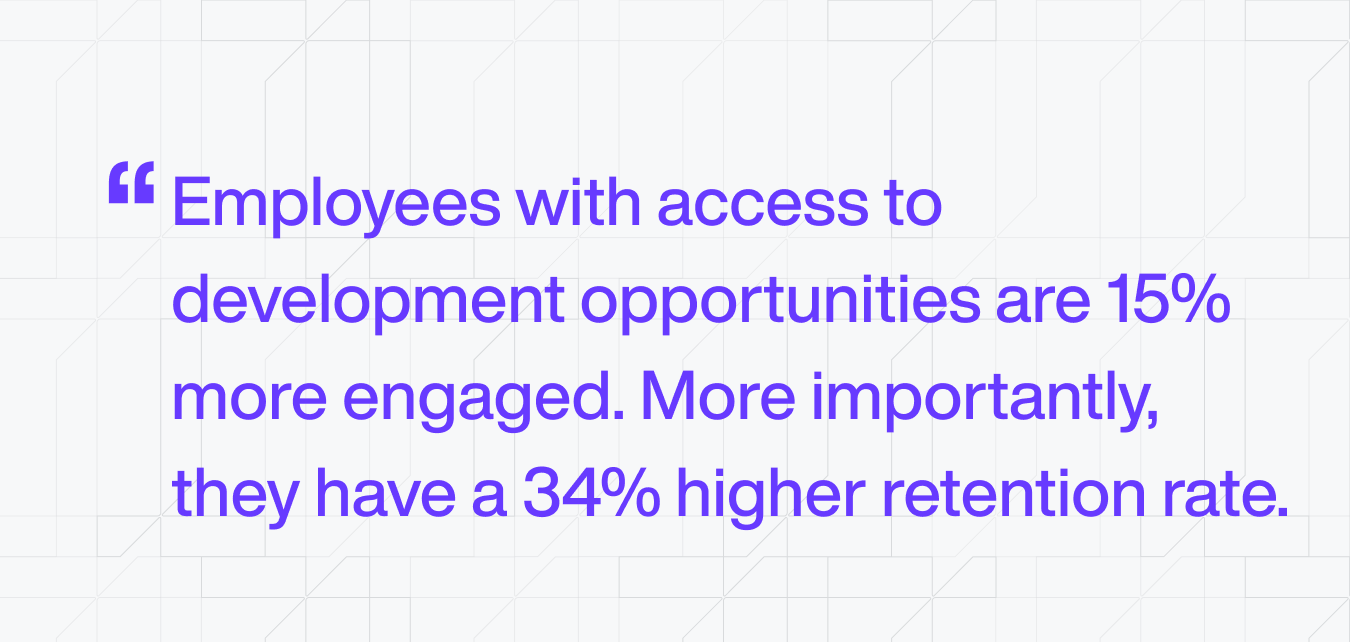How Training Your Team Can Fix Your Retention Problem

Going into 2022, retention is one of the single biggest challenges facing your business. In the middle of the Great Resignation (or the Big Quit as it's more informally known), companies are struggling to hold on to the talent they have, let alone grow their teams.
In this context, business leaders who do nothing could trigger a vicious cycle within their team that can easily turn into a terminal tailspin.
But the good news is, those who invest in developing their teams - especially by offering training in the most in-demand skills right now - can not only stop the decline, but actually trigger a positive cycle of engagement and growth.
Just How Bad Is the Great Resignation?
The short answer is ... very.
Almost 3% of the entire workforce in the US left their jobs in a single month of 2020. Across the US and Europe, the number of vacant job positions is increasing. The tech sector has been especially badly hit. Resignation rates increased by 4.5% in America's tech industry last year, making it one of the worst affected sectors.
And all of this is being driven by employees searching for more meaningful work and better work-life balance, combined with the increased opportunities remote working provides.
And this is not an issue that will be fixed any time soon. Recent research by Willis Towers Watson found that 61% of companies surveyed expect retention to remain a major problem in 2022.
And that is very bad news if you're a business leader, because losing employees is a much bigger problem than you may have first thought.

The Vicious Cycle Caused by Resignation
An employee leaving creates an obvious headache - you need to start recruiting for their replacement.
But the negative impact actually goes much deeper, creating a downward spiral that can be hard to stop:
- The productivity of your team drops because you are down one person
- Your sales decline and it is harder to hit your targets
- Your existing team has to work harder
- Morale suffers and team members lose motivation
- And this leads to more employees leaving, which starts the cycle again
The key message here is that resignation is a much bigger problem than just having to find a few additional hours to work on recruiting a replacement. If it is left unchecked, it can permanently damage your organisation.
Which means now is the time to think about retention.
Top 5 Employee Retention Strategies
Retention in 2022 is going to look a lot different to previous HR plans to keep employees happy. Writing in Harvard Business Review, Ian Cook suggests creating tailored retention plans for each of your team members. You can dig into the data on which types of employees are leaving and why, then come up with plans for each individual.
What might you include in these tailored retention plans? Well, this list of 5 retention strategies is a pretty good place to start. The strategies are:
- promote from within,
- invest in employee education,
- provide childcare support,
- offer flexible work arrangements,
- and implement recognition and rewards.
Start With a Focus on Training
Of all these strategies, starting with training makes the most sense. Here's why.
Flexible working is great, but there's a good chance you are offering this already. And if you're not, that's probably a long-term decision you've made that is not going to change.
Then there's childcare support. This is a very valuable strategy to use, but it won't be relevant for all of your employees. So you should definitely have this in your pipeline. But if you have to prioritise one strategy, you should pick one that will have a universal impact.
That leads us to promotions and recognition / rewards. These can definitely be applied to all employees, but, in order for them to be effective, they should be delivered at the right time. Simply creating new roles for your employees will feel forced and fake. As will loyalty bonuses, or just paying people more for sticking around. You absolutely need to practice recognising and rewarding your team, but they should be recognised for actually doing something. Otherwise, it's pretty meaningless.
So that leaves training, a strategy that ticks all the boxes:
- You can implement it immediately,
- It's suitable to all of your employees,
- It's meaningful and won't feel fake.
A recent survey of 2,000 employees by Better Buys found that employees with access to development opportunities are 15% more engaged. More importantly, they have a 34% higher retention rate.

Teach the Skills that Will Future-Proof Your Employees
And if you can provide training in the skills that will be most in-demand in 2022 - skills like data science, critical thinking and storytelling - then your employees will be able to both improve in their current role and enhance their career prospects.
One of the most impactful areas you can train your staff in is data analytics.
Businesses in every vertical are collecting data at an ever-increasing rate. We've heard for over a decade now that data is the new oil, fueling economic growth and improved efficiency. As all aspects of business continue to digitize, this trend is only accelerating. But the key to success is not simply having lots of data, it is understanding how to use it to improve business performance. And for this, you need data analytics.
Data analytics skills are relevant to a wide range of key decision-makers in your business - marketing heads, product managers, financial analysts, risk analysts and many more (read this detailed article on what Data Analysts and other data science professionals do to learn more). Imagine the business improvement you would see if your specialists in these areas all became better at interpreting the data they used. You would see fewer mistakes based on misunderstandings of what the data shows, coupled with a much wider range of actionable insights generated.
And for your employees - we are talking about retention after all - data analytics can be a very rewarding area to develop skills in. They will naturally understand how important these skills will be in future. Plus, it can be immensely satisfying for them to see old problems in new ways and to back up their decisions with accurately interpreted data.
How to Track Employee Training Progress
Along with considering which skills to offer training in, it is also important to think about how you track the training progress of your employees.
First of all, because you will be investing in your team, you'll want to make sure that they are actually developing thanks to the training they receive.
But secondly, and more importantly, tracking their progress shows that you are actually invested in their development. Simply organising a training course and showing no further interest will make the training seem tokenistic to your employees. You organised to show you are doing something for their development, but you don't actually care.

In contrast, tracking their progress, and then providing praise, encouragement and support, will show your team that you actually care about their development.
The good news is that the most up-to-date training courses make progress tracking quick and easy. Courses like Turing College's Data Science program are heavily data driven - they monitor a wide range of skills, both hard and soft, gathering data all the time. Then, via quick visualisations, you can see to get a complete picture of an employee's abilities and also the progress they are making.
This data can facilitate more meaningful coaching from managers, and improved decision-making when it comes to promotions from within your organisation.
From a Vicious Cycle to a Virtuous One
If an employee leaving creates a negative cycle, an employee upskilling can kick off a positive one.
Here's how it works:
- your employee becomes more motivated. That's because they feel valued, as you are investing in them. What's more, they probably find their work more engaging and meaningful because they are learning and applying new skills.
- they also become better at their job, thanks to the training they have received,
- they become more productive. After all, they are more motivated (as they feel valued and engaged) and more effective at their job (because they have new skills).
- their improved productivity benefits the team. They can take care of their own tasks, and maybe help others too. This reduces the burden of other members of their team.
- morale improves because the team is achieving, and is not over-burdened.
And this improvement in morale leads right back to the first point - your employees becoming more motivated.
So, as employees, you can choose from two cycles. One of them - a vicious cycle that will see more and more people leave and lead to drops in morale and productivity - will happen if you do nothing to improve employee retention. The other - a virtuous cycle that will not only retain your employees, but improve their performance and boost overall morale - will happen if you choose to invest in employee training and development.
But beware. This is a choice you have to make now. Delaying your decision is the same as choosing not to improve retention - and at this moment in time, that could be fatal for your business.
